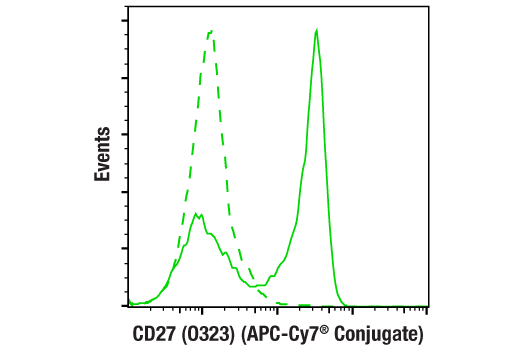FC-L
H
Endogenous
Mouse IgG1 kappa
#P26842
939
Product Information
Product Usage Information
| Application | Dilution |
|---|---|
| Flow Cytometry (Live) | 1:20 |
Storage
Specificity / Sensitivity
Species Reactivity:
Human
Source / Purification
This monoclonal antibody was purified from tissue culture supernatant via affinity chromatography. The purified antibody was conjugated under optimal conditions, with unreacted dye removed from the preparation.
Product Description
Background
CD27 (TNFRSF7) is a transmembrane protein of the TNF receptor superfamily (TNFRSF). It is mainly expressed on lymphoid cells (also on early hematopoietic precursor cells in mice) (1,2). CD27 is considered a phenotypic marker for memory B cells and is also used to identify B regulatory (Breg) cells (3,4). It is constitutively expressed on naïve CD4 and CD8 T cells and its expression is further upregulated upon T cell activation. CD27 is one of the two most important co-stimulatory receptors for T cell priming (the other one is CD28). While CD28 co-stimulatory signal mainly triggers cell proliferation, CD27 co-stimulatory signal primarily promotes cell survival and differentiation (5,6). Upon binding to its ligand CD70, CD27 activates the NF-κB and JNK signaling pathways through TNFR associated factors (TRAFs), the adaptor molecules that are associated with CD27 cytoplasmic tail domain. Upon activation, CD27 is shed from the cell surface and soluble CD27 is used as a marker of T cell activation (7,8).
- So, T. et al. (2006) Int J Hematol 83, 1-11.
- Waight, J.D. et al. (2017) Hum Antibodies 25, 87-109.
- Agematsu, K. (2000) Histol Histopathol 15, 573-6.
- Bouaziz, J.D. et al. (2012) Curr Mol Med 12, 519-27.
- Croft, M. Cytokine Growth Factor Rev 14, 265-73.
- Acuto, O. and Michel, F. (2003) Nat Rev Immunol 3, 939-51.
- Lens, S.M. et al. (1998) Semin Immunol 10, 491-9.
- van de Ven, K. and Borst, J. (2015) Immunotherapy 7, 655-67.
Species Reactivity
Species reactivity is determined by testing in at least one approved application (e.g., western blot).
Applications Key
FC-L: Flow Cytometry (Live)
Cross-Reactivity Key
H: human M: mouse R: rat Hm: hamster Mk: monkey Vir: virus Mi: mink C: chicken Dm: D. melanogaster X: Xenopus Z: zebrafish B: bovine Dg: dog Pg: pig Sc: S. cerevisiae Ce: C. elegans Hr: horse GP: Guinea Pig Rab: rabbit All: all species expected
Trademarks and Patents
Limited Uses
Except as otherwise expressly agreed in a writing signed by a legally authorized representative of CST, the following terms apply to Products provided by CST, its affiliates or its distributors. Any Customer's terms and conditions that are in addition to, or different from, those contained herein, unless separately accepted in writing by a legally authorized representative of CST, are rejected and are of no force or effect.
Products are labeled with For Research Use Only or a similar labeling statement and have not been approved, cleared, or licensed by the FDA or other regulatory foreign or domestic entity, for any purpose. Customer shall not use any Product for any diagnostic or therapeutic purpose, or otherwise in any manner that conflicts with its labeling statement. Products sold or licensed by CST are provided for Customer as the end-user and solely for research and development uses. Any use of Product for diagnostic, prophylactic or therapeutic purposes, or any purchase of Product for resale (alone or as a component) or other commercial purpose, requires a separate license from CST. Customer shall (a) not sell, license, loan, donate or otherwise transfer or make available any Product to any third party, whether alone or in combination with other materials, or use the Products to manufacture any commercial products, (b) not copy, modify, reverse engineer, decompile, disassemble or otherwise attempt to discover the underlying structure or technology of the Products, or use the Products for the purpose of developing any products or services that would compete with CST products or services, (c) not alter or remove from the Products any trademarks, trade names, logos, patent or copyright notices or markings, (d) use the Products solely in accordance with CST Product Terms of Sale and any applicable documentation, and (e) comply with any license, terms of service or similar agreement with respect to any third party products or services used by Customer in connection with the Products.
